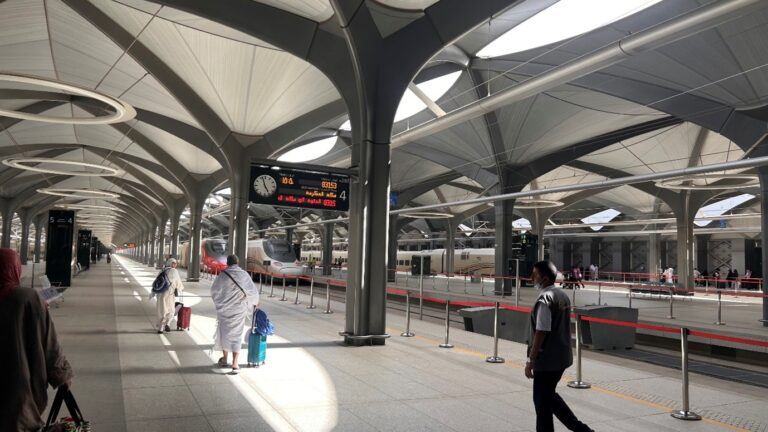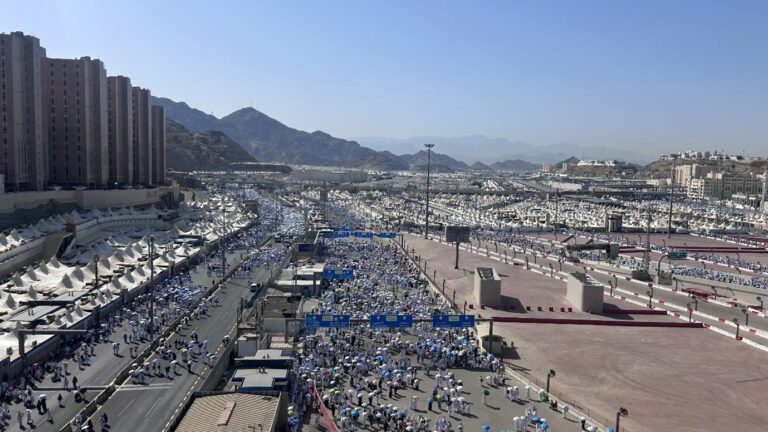In this latest IPEX Insight, M. Umar Saleem, one of our Associate Directors, reflects on his Hajj experience, and how the transport infrastructure of Saudi Arabia now and into the future is an enabler for one of the world’s great pilgrimages.
This year, I had the profound privilege of performing Hajj – a spiritual journey that also offered a unique lens into the evolving landscape of transport infrastructure in Saudi Arabia. After a brief stay in Madinah, I travelled to Makkah aboard the Haramain High-Speed Railway, covering 280 miles in just under two and a half hours. The journey was remarkably smooth and efficient, departing from the architecturally stunning Madinah station. It also marked my first experience aboard a Talgo 350 (RENFE Class 102) train, whose innovative ‘rodal’ system delivered a ride that was both quiet and stable; an impressive showcase of modern rolling stock engineering.
Figure 1. Haramain High- Speed at Madinah station

Over the sacred days of Hajj, more than 1.6 million pilgrims moved between the holy sites of Mina, Muzdalifah, Arafat, and the Jamarat Bridge. Despite the intense summer heat, the movement of worshippers was facilitated through a combination of pedestrian routes, buses, and the Mashaer Metro system. This year, the Mashaer Metro operated over 2,000 trips using a fleet of 17 trains, each capable of carrying 3,000 passengers. With a total capacity exceeding 72,000 passengers per hour, the system played a critical role in reducing congestion and emissions across the holy sites.
Figure 2. Worshippers travelling during the days of Hajj to the Jamarat

Looking ahead, Saudi Arabia’s Vision 2030 programme continues to drive ambitious infrastructure development. The Masar Destination project in Makkah aims to increase pilgrim capacity to 30 million annually. The latest expansion of the Grand Mosque is already partially open for prayers, and its scale and architectural grandeur are awe-inspiring. Once complete, the surrounding urban landscape is expected to transform significantly, with plans to pedestrianise the immediate vicinity and rely heavily on public metro systems to manage the anticipated surge in footfall.
Figure 3. Masjid-al-Haram’s latest expansion features increased prayer spaces, ablution facilities, restrooms, and advanced climate control systems

The Haramain High-Speed Railway, too, is scaling up. For Hajj 2025, Saudi Arabia Railways (SAR) increased seat availability by 25%, offering nearly 2 million seats to accommodate the growing number of pilgrims. These enhancements reflect a broader commitment to sustainable, high-capacity transport solutions that align with the Kingdom’s National Transport and Logistics Strategy.
As the Kingdom continues to invest in smart, scalable, and sustainable transport infrastructure, rail will remain central to enabling the safe and efficient movement of millions of pilgrims. The next decade promises to be a defining chapter in the convergence of faith, innovation, and mobility.
References:
- Saudi Arabia Railways: com.sa [sar.com.sa]
- The Ministry of Transport and Logistics: gov.sa [mot.gov.sa]
- Vision 2030 transport plans: gov.sa [vision2030.gov.sa]
- Haramain High‑Speed Railway official site: hhr.sa [sar.hhr.sa]